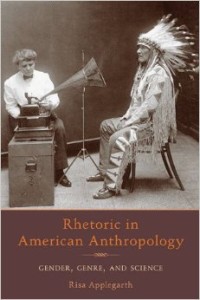Book Review: Applegarth’s Rhetoric in American Anthropology
Applegarth, Risa. Rhetoric in American Anthropology: Gender, Genre, and Science. Pittsburgh, PA: U Pittsburgh P, 2014. Print.
 In what develops as a performance of “rhetorical archaeology” in Rhetoric in American Anthropology: Gender, Genre, and Science (17), Risa Applegarth examines anthropological genres in development, resistance, and flux in the early twentieth century. By rooting her study in rhetorical genre theory, Applegarth demonstrates how writers manipulate, craft, or resist genres despite the pressures of professionalization and the denial of access to women and minorities. For researchers interested in historical applications of genre theory, Applegarth’s book provides a view of anthropology through the texts produced as the field matured, crafting a “counterstory” (8) to the narrative that the ethnographic monograph represents the only legitimate way of making knowledge in anthropology and revealing “an alternative scientific practice” (8) contained in other genres.
In what develops as a performance of “rhetorical archaeology” in Rhetoric in American Anthropology: Gender, Genre, and Science (17), Risa Applegarth examines anthropological genres in development, resistance, and flux in the early twentieth century. By rooting her study in rhetorical genre theory, Applegarth demonstrates how writers manipulate, craft, or resist genres despite the pressures of professionalization and the denial of access to women and minorities. For researchers interested in historical applications of genre theory, Applegarth’s book provides a view of anthropology through the texts produced as the field matured, crafting a “counterstory” (8) to the narrative that the ethnographic monograph represents the only legitimate way of making knowledge in anthropology and revealing “an alternative scientific practice” (8) contained in other genres.
Professionalization and the Emergence of the Monograph Genre
In keeping with a genre-based approach, Applegarth divides her chapters into the types of writing under study: ethnographic monographs, field autobiographies, folklore collections, and ethnographic novels. The introductory chapter along with the second, “Ethnographic Monographs,” establishes the goal of her project against the historical backdrop of anthropology’s shift from amateur to professional status. In the nineteenth century, anthropology was promoted as an open science, a field where women were valued for their ability to gain access to spaces forbidden to men, to provide essential contributions to the discipline. However, in the early decades of the twentieth century, a shift toward professional status began to undermine this philosophy of access. Applegarth demonstrates that the emergence and solidification of the ethnographic monograph genre as the primary vehicle for anthropological knowledge was part of the move away from amateur fieldwork to research conducted by more stringently trained academics. For instance, in Argonauts of the Western Pacific, Bronislaw Malinowski “reframes the earlier involvement of amateur anthropologists as a symptom of anthropology’s scientific immaturity and suggests that, in fact, anthropology is only now, in 1922, capable of attacking the problem of human history with properly scientific methods” (26). Here is where Applegarth examines the role of the monograph in producing “rhetorical scarcity” as well as permitting those who use the genre to “police genre and community boundaries” (29, emphasis in original). Rhetorical scarcity creates the conditions by which rhetors are denied access “to key rhetorical resources” (29) such as fieldwork, which then constrains their ability to produce the genre necessary for success and full professional participation. As Applegarth argues, because women (whose bodies were often seen as interfering in fieldwork) were denied access to research sites and to PhD study through a lack of funding, mentors, or admission to the newly developing graduate programs, they were prevented from producing monographs that would ensure their place within the profession.
To establish the development of the monograph in anthropology, Applegarth divides her analysis between pre-1920 and post-1920 texts to demonstrate how genre shifts have their roots in the changing social and cultural conditions surrounding the practice of anthropology. Before 1920, monographs varied in length, training of their writers, level of data analysis, and technical language, revealing flexibility in what was considered possible as an instance of the genre, though she argues that they were united in their use of spatial synecdoche and flexible fieldwork as the basis of their knowledge-making. Spatial synecdoche enabled diverse writers to place their work within a larger map of discovery, thus uniting projects in a common disciplinary goal, while flexible fieldwork permitted a range of practices to be available to practitioners. Yet after 1920, these two rhetorical resources began to shift to an emphasis on one kind of fieldwork and the use of spatial synecdoche to create generalizable knowledge. This shift, as represented in the ethnographic monographs published after 1920, enabled anthropologists to align their work within standards of the knowledge produced in empirical science, though at the cost of marginalizing the anthropologists unable to access the resources necessary: women and minorities.
Alternative Genres as Sites of Resistance
Subsequent chapters thus focus on various texts that emerge as alternative genres to push against the ethnographic monograph and the implied assertion that there was only one way of creating knowledge. Applegarth begins with “Field Autobiographies,” which she argues were written in response to the marginalization women experienced as they attempted to conduct fieldwork with fewer (or none) of the resources afforded to men. These autobiographies, blending generic features of monograph and autobiography, functioned as a way for women to assert their place as professionals within a field that often regarded them as mere assistants to the “real” researchers. Applegarth’s argument relies on Wendy Sharer’s concept of genre work or “a genre-based form of rhetorical innovation that permits writers to meet and to contest community-based discursive norms simultaneously” (63). Because women were continually denied access to anthropology, despite its characterization as a “welcoming science,” the field autobiography enables its writers to assert themselves as professional practitioners, as researchers pursuing invaluable knowledge, and as individuals whose identity exists “primarily in relation to a research community rather than in relation to a personal or familial history” (65). The two authors Applegarth analyzes both attempt to use the field autobiography as a method to legitimate their place in the field as well as “to shape their community, its current practices, and potential futures” (69).
From field autobiographies, Applegarth turns her attention to folklore collections, a common genre in anthropological study. In this chapter, however, Applegarth examines how women and minorities—specifically anthropologists and writers Ella Cara Deloria, a Yankton Nakota, and Zora Neale Hurston, an African American—use their folklore collections to challenge assumptions made about folklore and data collection methods. Deloria and Hurston both refuse to strip the context from the stories they collect, recognizing its necessity in understanding the full cultural significance of a particular instance of telling. By providing the contexts, these writers demonstrate that folklore cannot be removed from the specific instance of its telling, nor are the stories generalizable from that context, nor are the tales in danger of being lost if they are not recorded by researchers because they are so actively in use. Both Deloria and Hurston examine their own communities and are able to position themselves as insiders, or as researchers who can better explain the language and the stories and the communities they study: “both writers generated knowledge through writing practices that resisted the abstraction and decontextualization that underwrote anthropology’s claims to epistemic authority” (97). These writers, through their manipulation of the genre, challenged the norms of scientific practice and present an alternate, but in no way less valid, form of knowledge.
The final genre Applegarth examines is the ethnographic novel, which, like the other genres she examines, serves as a location to negotiate the goals of anthropological study. While it is no longer produced, “emerging and then fading from practice within a decade” (139), the ethnographic novel was published widely in the 1930s as a way of conveying the findings of anthropology to a broader audience. While these novels are fictionalized accounts of Native culture, they promoted themselves as scientifically accurate depictions in an attempt to influence public policy and undermine popular stereotypes. Instead of abstracting and generalizing their knowledge, writers of these novels sought to particularize and to humanize the subjects of anthropological study. As Applegarth argues, “Through fictional narratives, these rhetors sought to make both real and moving a situation that, in other genres, remained abstract or out of sight” (152). Thus this genre became a powerful tool to not only provide an alternative representation of scientific knowledge but also to appeal to a broader, non-academic audience to attempt to shift public policy and attitudes that threatened the survival of Native cultures.
Taken together, Applegarth asserts that the field autobiography, folklore collection, and ethnographic novel emerge as genres that function to resist the pressures of professionalization, and they provided alternatives to scientific practice that increasingly moved women and minority researchers to the edges of the field and also offered problematic abstractions of the cultures under study.
Genre Trouble
Rhetoric in American Anthropology is part of the Pittsburgh Series in Composition, Literacy, and Culture, which strives to publish books that cut across disciplinary lines “with the purpose of provoking reflection about disciplinary practices” (Shanholtzer 2). Given that her audience may be from a variety of academic backgrounds, Applegarth is forced to spend a substantial amount of time establishing the conventions in place—the social context—in order to effectively frame her analysis of each genre. Obviously, this context is essential to understanding how these genres functioned as a counterstory and how they represented sites of resistance within the professionalization taking place in the early 20th century. At times, however, the genre analysis itself seems secondary; she does not begin her analysis until partway through the third chapter. As a reader, I wanted to know more about the texts under examination and felt somewhat dissatisfied by the space allotted to the analysis, at least in the first part of the book. The later chapters make up for this slow start, however, and the argument develops clearly and strongly by the conclusion, rooted in the invaluable analysis of the texts that she recovers.
Another more critical concern emerges in the chapter “Field Autobiographies,” where Applegarth focuses on two sets of texts written by women: Digging in Yucatan and Digging in the Southwest by Ann Axtell Morris and Spider Woman by Gladys Reichard. In terms of their use to undermine the authority claimed by the ethnographic monograph, these field autobiographies can be read as part of the counterstory Applegarth argues for; she demonstrates how these two writers in particular are conscious of the ways their gendered bodies are part of the material conditions that affect their ability to produce knowledge and be seen as professionals. Yet, I was troubled by the fact that Morris writes not as an anthropologist but as an archaeologist, a distinction Applegarth never accounts for except to note that “Field autobiographies, then, offer writers a means for forging a relationship between a narrated self, a specific material location and a broader academic community: in the case, the professionalizing disciplines of archaeology and anthropology” (66-67). In other words, Applegarth notices the similarities in both fields and how Morris (the archaeologist) and Reichard (the anthropologist) both use the field autobiography to establish themselves as professionals, but she fails to address that they are working in distinct, though connected, fields. Glossing over the use of an archaeological text within a study oriented around anthropological history and practices ignores the particular features of archaeology that differ from anthropology. Since genre analysis should account for the specific historical and social contexts and especially given Applegarth’s clear concern with establishing context in the early chapters that almost overshadows her analysis, her neglect to provide a clearer rationale is even more problematic. One reason that Applegarth places them together despite their disciplinary difference is that they are the only two examples of “field autobiography” that she has found. One book does not a genre make; therefore, had she focused only on Reichard’s anthropological text, she would not be able to argue that the field autobiography constituted a genre written in response to the ethnographic monograph. Granted, certain connections and parallels demonstrate that both Morris and Reichard responded similarly to similar contexts, a key element of Carolyn Miller’s definition of a genre as “typified rhetorical actions based in recurrent situations” (159). However, some accounting for the disciplinary difference would enable Applegarth to justify using these two authors as evidence of a genre that represents an alternative scientific practice within anthropology and related fields.
Despite these drawbacks, one likely unavoidable given the targeted audience, Applegarth succeeds in her rhetorical archeology, recovering lost or hidden texts and restoring their place within anthropological disciplinary formation. Indeed, Rhetoric in American Anthropology “crosses traditional boundaries” (Shanholtzer 2) as stated in the goals of the series by using rhetorical genre theory to disrupt the traditional narrative of professionalization in anthropology and to recover the contributions of women working in the early twentieth century.
Works Cited
- Applegarth, Risa. Rhetoric in American Anthropology: Gender, Genre, and Science. Pittsburgh: U Pittsburgh P, 2014. Print.
- Miller, Carolyn. “Genre as Social Action.” Quarterly Journal of Speech 70 (1984): 151-67. Print.
- Shanholtzer, Josh. Pittsburgh Series in Composition, Literacy, and Culture: New and Forthcoming Titles 2014. University of Pittsburgh Press, 2014. Web. 9 Feb. 2015.




 Jennifer Mallette is an Assistant Professor of English at Boise State University, where she researches and teaches technical communication. Her primary research interests are in STEM writing and pedagogy, genre theory,and gender and science. She is currently researching the impact of gendered experience on women's writing practices in engineering settings with the aim of both recognizing contributions by women in engineering as well as exploring ways writing can be used to promote equity in male-dominated fields.
Jennifer Mallette is an Assistant Professor of English at Boise State University, where she researches and teaches technical communication. Her primary research interests are in STEM writing and pedagogy, genre theory,and gender and science. She is currently researching the impact of gendered experience on women's writing practices in engineering settings with the aim of both recognizing contributions by women in engineering as well as exploring ways writing can be used to promote equity in male-dominated fields.